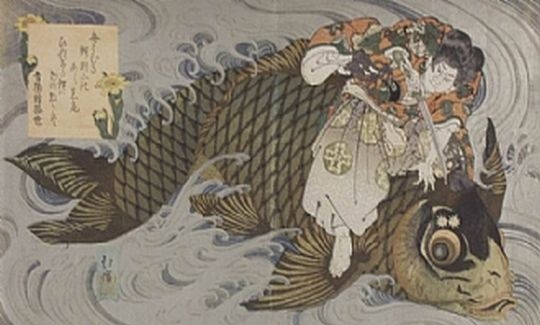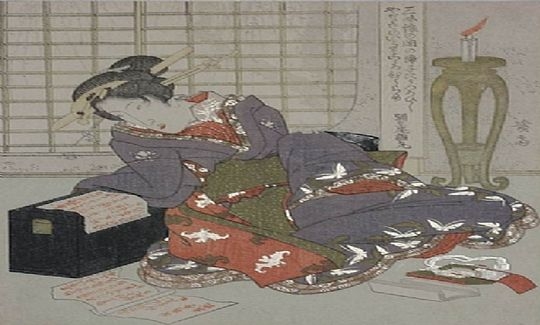The collections of the Tikotin Museum of Japanese Art include some 500 surimono prints (摺物, surimono: "something printed"), most of them from the collection of the Museum's founder, Felix Tikotin. Surimono are greeting-cards, invitations to recitals and concerts, and announcements of various events. The majority of surimono prints were produced during the 1790s-1830s, printed on paper of shikishiban (色紙判) size (appr. 20.5x18.5 cm.). This is the paper size customarily used in Japan since the Heian period (794-1185) for writing the classic waka (和歌) poetry of 31 syllables. When printing larger surimono for programmes of events or for several poems, the yokonagaban (横長判) - "long horizontal prints" (appr. 42x58 cm.) were used, folded lengthwise. Of these, half was used for the decoration, the other half for the text.
Unlike other woodblock prints sold in the Edo period (1600-1868) in large numbers, the surimono were published in small editions and were not intended for sale. Additionally, they were not exposed to censorship to the same extent as the commercial prints. The surimono were intended for the educated public, knowledgeable and versed in the arts of literature, poetry and calligraphy. Many surimono prints were ordered by kyoka (狂歌) and haiku (俳句) poetry clubs (kyoka: comic poems of 31 syllables; haiku: short verses of 17 syllables). Kabuki actors also commissioned surimono to publicize changing their names or first performances of their sons.
Integrating kyoka verses in surimono was fashionable from the 1780s until the 1830s, while the integration of haiku continued until the mid-19th century. Kyoka appearing on the prints are mainly winners of poetry competitions. They were also created by the artists who designed the prints, and by famous poets. The verses are integral to the design, complementing it in regard to both subject and composition. The kyoka are often satires or parodies of classic poems, so it is hardly surprising that the surimono artists preferred the shikishiban, the paper size used for writing classic poetry in the Heian era.
The surimono was apparently a development of the egoyomi (絵暦) - illustrated calendars that were popular from the mid-1760s. The Japanese lunar calendar, in use until the mid-19th century, included long months of 30 days, and short months of 29 days. Every few years, an extra month was added to ensure that the New Year would commence on time. Saiten surimono (歳旦摺物) are new-year greeting cards ordered by private customers. The poems and embellishments on them convey hints and messages that have double meanings. Chinese symbols signify specific events; a creature from the horoscope signifying the New Year, or plants that bloom in a specific season are "concealed" in such prints, so that interpreting surimono presents a considerable challenge.
Because there was no commercial element in the production of surimono, there was no attempt to economize. The best artists, carvers, and printers were invited to design them, and they were printed with expensive colours and materials such as powdered gold and silver, using special techniques - "blind prints" without colour, metal inlays, etc., on fine paper (奉書, hosho). The great variety of subjects chosen includes historic or imaginary events, scenes from natural life, still-life, beautiful women, the Kabuki Theatre, and many others. The most exquisite surimono were designed by Katsushika Hokusai (1760-1849), his pupil Totoya Hokkei (1780-1850), Kubo Shunman (1757-1820), and Yashima Gakutei (1786?-1868).



